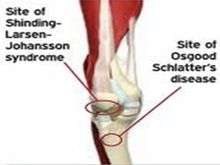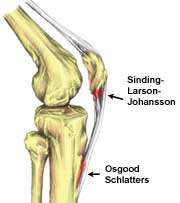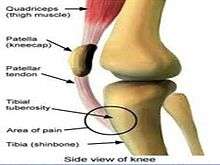Sinding-Larsen and Johansson syndrome
| Sinding-Larsen and Johansson syndrome | |
|---|---|
| Classification and external resources |
Sinding-Larsen and Johansson syndrome,[1] named after Swedish surgeon Sven Christian Johansson (1880-1959),[2] and Christian Magnus Falsen Sinding-Larsen (1866-1930),[3] a Norwegian physician, is an analogous condition to Osgood–Schlatter disease involving the patellar tendon and the lower margin of the patella bone, instead of the upper margin of the tibia, as is the case in Osgood-Schlatter. This variant was discovered in 1908, during a winter indoor Olympic qualifier event in Scandinavia. Sever's disease is a similar condition affecting the heel.
This condition called Sinding-Larsen and Johansson syndrome was described independently by Sinding-Larsen in 1921 and Johansson in 1922.[4]

Clinical presentation
The condition is usually seen in athletic individuals typically between 10–14 years of age. Following a strain or partial rupture of patellar ligament the patient develops a traction ‘tendinitis’ characterized by pain and point tenderness at the inferior (lower) pole of the patella associated with focal swelling.
Children with cerebral palsy are particularly prone to SLJ 4.


Treatment
With rest and quadriceps flexibility exercises the condition settles with no secondary disability. Sometimes, if the condition does not settle, calcification appears in the ligament. This condition is comparable to Osgood-Schlatter’s disease and usually recovers spontaneously. If rest fails to provide relief, the abnormal area is removed and the paratenon is stripped.
References
- ↑ Sinding-Larsen and Johansson syndrome at Who Named It?
- ↑ Sven Christian Johansson at Who Named It?
- ↑ Christian Magnus Falsen Sinding-Larsen at Who Named It?
- ↑ APLEYS system of orthopaedics 9th edition
| Wikimedia Commons has media related to Osgood–Schlatter disease. |